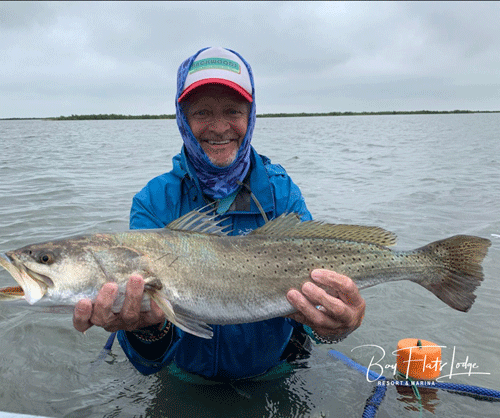
“Pre-Fall Gal”
Capt. Chris Martin
The brief cool fronts that we tend to get during this month will probably place the fishing in somewhat of a springtime pattern. This being the case, and in conjunction with the higher tides that we’ll continue seeing, coastal bend anglers in search of repeated success will be focusing a fair percentage of their efforts in locations situated deep within the back lakes region of Matagorda Island.
The back lakes have recently produced attractive trout and redfish catches, but searching for and locating active accumulations of baitfish will need to be your first priority. In looking for schools of mullet, try wading along shorelines that are made up of scattered grass beds. These grass beds often hold food sources for the mullet, and can also serve as a safe haven from predators, as well. Look for the trout to be located above these grassy patches in water that is clear and green. And look to find backcountry redfish to be schooled-up tight to the shoreline in some of the more murky water covering the grass and mud.
Anglers can begin their daily regimen in these secluded areas by tossing top water baits early, and then transition to plastic tails or slow-sinkers later in the morning. In selecting a top water bait to start your day, you may wish to pick one of the smaller ones, as these may more closely resemble small silver shad or mullet. Plus, small top water baits tend to make a lot less noise when casted upon the surface of calm waters that are so often found in the back lakes. A couple of top producers have been surface baits like the Super Spook Junior and the Skitter Walk Junior in some of the more brighter color patterns whenever fishing in clear, clean water on a bright sunny day, and some of the darker color patterns whenever fishing in off-colored water on an overcast day.
When it comes to plastics, one of the best tails to be tossing this month is sand eels, especially for redfish action. And, of course, favored slow-sinkers still include the entire line of the Corky baits – the original Corky, the Fat Boy, the Corky Devil, and even the MirrOdine lures. Anglers should also never discount the use of the old reliable gold and silver spoon this month, as spoons definitely have historical merit in times when things begin to cool-off a bit along the coast.
Remembering that the days will be getting shorter now and that there will be less hours of daylight with each passing day, anglers can generally begin transitioning to the presentation of dark-colored lures on a regular basis if they should prefer to do so. Darker lures tend to imitate a silhouette symbolic of natural bait, and the darker the silhouette will mean better reflection of the bait against the upward sunlight. Here’s to a great month for fishing! Keep grindin’!
